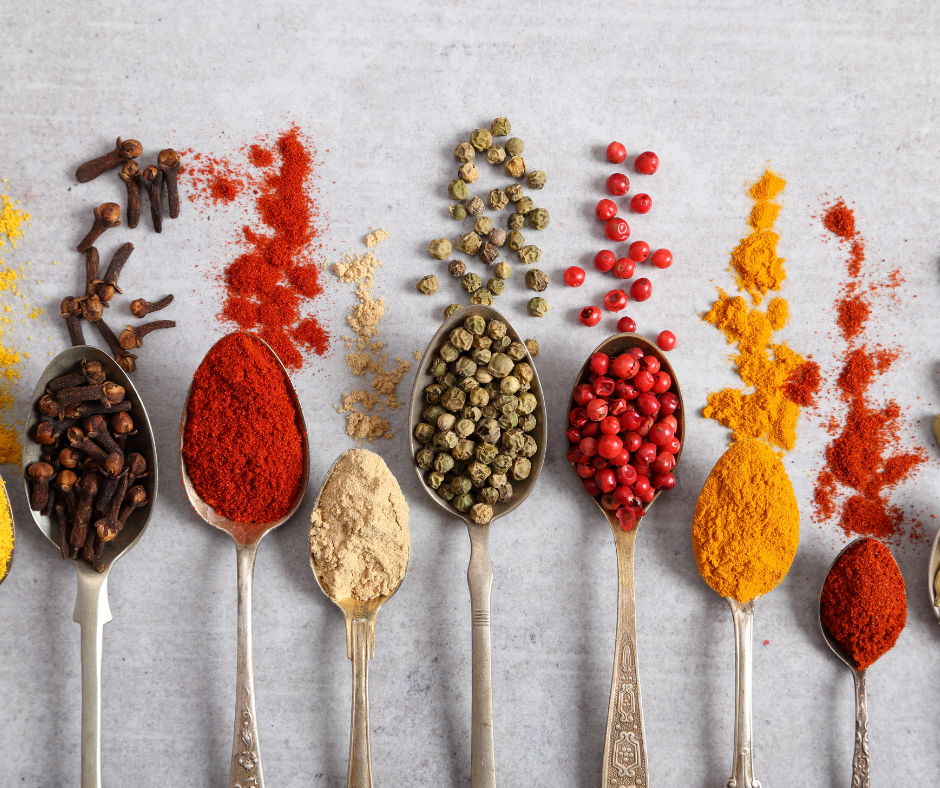Take Your Meals from “Meh.” to “Hot Diggity!”
Let’s talk about seasoning your meals. As you know, adding spices, dried herbs, and fresh herbs will amp up the flavor of your meals! Yet, where do we begin? Which seasonings pair well together? Which spices are best on specific foods? Let’s break it all down.
Spice Shelf-Life:
Raise your hand if your kitchen spice cabinet is a black hole for seasonings…... Better yet…. When was the last time you checked the expiration dates?!
Wait… spices expire?!
Adding flavor to your meals can be simple, the best way to begin is to ensure that your seasonings are fresh. Dried herbs and spices don’t go bad the way milk spoils; the main result of aged seasonings is dull flavor. Great food starts with great ingredients! Generally speaking, herbs and spices have a shelf life of 1-3 years. Sticking within that timeline will ensure brighter more flavorful meals.
Fresh VS Dried:
When should you be using fresh herbs versus dried herbs? Both ingredients have their pros and cons. Fresh herbs, are bright in flavor, and color! Dried herbs are convenient and build flavor over time. Both ingredients have a time and a place.
Fresh Herbs….
Fresh herbs will easily elevate the flavor of any dish and they have several uses. Also, fresh herbs are mini vegetables! They too are leafy greens! Fresh herbs are loaded with vitamins, minerals, and phytochemicals. Don’t skimp on these nutrient rich powerhouses, think of them as salad greens, they are so good for you and delicious! When using fresh herbs in a recipe consider this, fresh herbs will darken in color over-heat, if you want that bright color it’s best to add these colorful leaves at the end of the cooking process or on foods that don’t need heat. Although, let’s not forget that fresh herbs can be mixed into dishes to brighten the entire dish or used as herb rubs on foods.
Here is a breakdown on how to decipher; what, where, and when to use fresh herbs:
Foods that don’t need heat; Pesto, herbed hummus, salsa, vinaigrettes, chimichurri sauce, folded into salad greens.
Added at the end of the cooking process; on top of your Tuesday taco, whipped into garlic rosemary potatoes.
Added at the beginning or during cooking: Stirred into an herb mushroom risotto, combine with lemon zest for an herb crust on your Thanksgiving turkey.
Dried Herbs….
Dried herbs and spices are a fantastic addition to your meals too! For some reason, dried herbs and spices have gotten a lame reputation, however that is so WRONG! Dried herbs are convenient, packed with flavor, and good for you. Good for you too? Yes! These convenient flavor bombs are packed with phytochemicals and antioxidants. Have fun with dried herbs and spices, they can easily take a dish up a few notches.
Two Main Tips for Cooking with Dried Herbs:
Substituting in place of fresh: If a recipe calls for 1 tablespoon of fresh oregano you can easily substitute ½ tablespoon instead. Remember that dried herbs are more condensed, there is far more bang in each shake.
Blooming flavor: Dried herbs and spices build flavor once they are in contact with moisture. You know how chili or lasagna gets better the second or third night after you’ve cooked it? That is what we are talking about here. The takeaway is this- when you add dried herbs allow the moisture time to rehydrate and develop the herbs to their full flavor potential. This is especially true with crushed red pepper flakes, be careful not to add too much of a good thing. The crushed red pepper flakes will become spicier as they sit in moisture during the cooking process or just in the fridge.
Check out this helpful table of spices to help decide when and where to sprinkle your favorites herbs and spices according to the type of cuisine you are cooking.
Happy Cooking! XO



